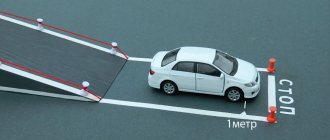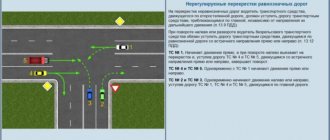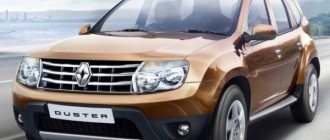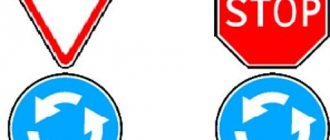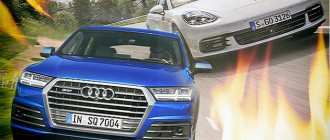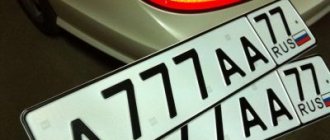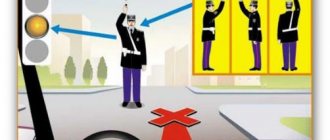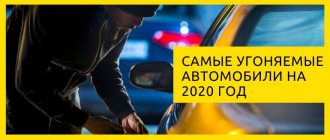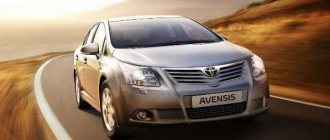Turning left is considered one of the most difficult maneuvers for new drivers. Many intersections with heavy traffic flow are designed in such a way that turning left requires several steps. This is scary only in words, in fact, all the difficulties will be forgotten as soon as the driver gains experience.
- 2 Turn left when driving on the main road
- 3 Left turn when driving on a secondary road
- 4 Left turn if there is an additional traffic light section
- 5 Left turn at equivalent intersection
- 6 How to avoid accidents when turning left?
From which lane is a left turn allowed?
First, let's look at the most ordinary intersection, where there are no signs or markings that determine the directions of traffic along the lanes:
In this case, the choice of lane is regulated by paragraph 8.5 of the traffic rules:
8.5. Before turning right, left or making a U-turn, the driver is obliged to take in advance the appropriate extreme position on the roadway intended for traffic in this direction, except in cases where a turn is made when entering an intersection where a roundabout is organized.
Thus, turning is only allowed from the left lane. Moreover, you need to not only take the left lane, but also the extreme left position on this lane (the white car in the picture above). That is, the car should be located as close as possible to the markings separating the oncoming direction.
You need to understand that turning left from the right lane will entail a fine of 1,000 - 1,500 rubles:
Turn left from two lanes
In the traffic rules, there are special signs and markings that allow you to establish a different order of traffic on the lanes. If there are such signs and (or) markings, a left turn can be made from several lanes:
In the figure above, signs 5.15.2 allow you to turn left from both the left lane and the middle lane. Usually this situation does not cause problems for drivers. The white car turns into the left lane, and the orange car turns into the right. That is, the trajectories do not intersect.
However, if you carefully study the text of the traffic rules, you will notice ambiguity. On the one hand, paragraph 8.5 requires you to take the extreme left position before turning left. On the other hand, signs 5.15.2 allow turning from two lanes. Moreover, the rules do not say that if signs 5.15.2 are present, clause 8.5 ceases to apply. That is, if we take the traffic rules literally, it turns out that the use of signs allowing simultaneous turns from several lanes is meaningless, because Drivers must still only turn from the left lane. However, in practice, there is no fine for turning from the middle lane if there is a sign 5.15.2 allowing a turn.
In practice, questions may arise in the event of an accident while turning left at the same time. Since the situation is not regulated by other clauses of the rules, clause 8.9 applies:
8.9. In cases where the trajectories of vehicles intersect, and the order of passage is not specified by the Rules, the driver to whom the vehicle is approaching from the right must give way.
That is, the orange car is on the right and has the right of way, and the white one must give way to it.
Turn left from tram tracks
The intersections through which tram tracks run at the same level as the asphalt deserve special attention:
The situation is regulated by the second paragraph of clause 8.5 of the traffic rules:
If there are tram tracks in the same direction on the left, located at the same level as the roadway, a left turn and a U-turn must be made from them, unless signs 5.15.1 or 5.15.2 or markings 1.18 prescribe a different movement order. In this case, there should be no interference with the tram.
That is, in the example above, the white car can turn left only from the passing tram track. The situation is discussed in more detail in the article:
The traffic light stopped working when entering an intersection
Imagine the situation - you are approaching a controlled intersection and the traffic light suddenly goes out. What to do in this case? First of all, you need to stop and assess the situation. The situation is non-standard, so it will not be possible to make a quick decision.
The second step is to study the road signs, understand where the main road is and who must yield. However, do not forget paragraph 13.2 of the traffic rules, indicating that it is prohibited to leave if there is a traffic jam at the intersection. This rule says that you should not immediately press the gas pedal if you have an advantage. In case of an accident, law enforcement agencies will consider clause 13.2 and will make you guilty of the collision.
How to properly turn left at an intersection?
Traffic rules allow you to choose any trajectory within the intersection of roadways.
Let's figure out how to choose the optimal trajectory when turning left. To do this, you need to consider 2 situations:
- Vehicles from the opposite direction do not turn left (they have a prohibiting traffic light, a sign prohibits them from turning left, or there is simply no one willing to turn).
- Oncoming cars turn left.
Oncoming cars do not turn left
In this case, nothing prevents you from driving straight through the intersection and stopping opposite the required lane. As soon as it becomes possible to turn left, you need to turn left and leave the intersection.
This trajectory solves several problems simultaneously:
- the car does not interfere with the passage of oncoming cars, because located on the “following” side of the intersection;
- when leaving the intersection of roadways, the car will not accidentally drive into oncoming traffic;
- If another car decides to turn at the same time as you, it will always be on the left, i.e. he won't have to give in.
Oncoming cars turn left
There are no uniform rules for passing at an intersection when turning left. You can pass oncoming traffic using both left and right sides:
In practice, the choice of passing pattern depends on the configuration of the intersection. In this case, starboard passing is more often used, because cars do not interfere with each other.
Note. At an intersection with a median, you should pass on the left side, because otherwise, when leaving the intersection of roadways, your car will end up in the oncoming lane, and this is prohibited by the rules.
What is considered a violation
When turning along a short trajectory, the driver must calculate whether he will drive into a solid dividing strip, a pedestrian zebra crossing or a curb located on the roadways. All this is a violation of traffic rules.
If the car starts moving, but encounters the above obstacles on the way, then the citizen driving it should remember: at the intersection it is forbidden to back up and make a U-turn in several steps.
An important point when entering a controlled intersection is the ability to complete the maneuver at the permissive traffic light signal. If there is a traffic jam at the intersection of roadways, the car will have to stop, which can subsequently create an obstacle for oncoming vehicles.
A driver who sees that because of a traffic jam he will not be able to turn around (and this can be easily understood by the timer installed at the traffic light) should not drive into the intersection.
Which lane should I take after the turn?
8.6. The turn must be carried out in such a way that when leaving the intersection of roadways the vehicle does not end up on the side of oncoming traffic.
After making a left turn, the driver can choose to move in any passing lane ; the rules do not impose any restrictions.
As a rule, drivers choose the left lane to drive in order to avoid crossing with oncoming cars turning right. However, this is not necessary. You can let oncoming cars pass and even turn into the right lane.
Note. Don't forget that when turning right, different rules apply. You must move as close to the right edge of the roadway as possible. That is, you cannot select any band.
Responsibility
As with other violations of the Traffic Rules, when making an incorrect turn at an intersection, the driver may face an administrative fine or confiscation of his driver’s license.
It all depends on the type of action:
| Violation | Punishment |
| Warning or penalty in the amount of five hundred rubles |
| Fine one thousand rubles |
| Collection from one to one and a half thousand rubles |
| Drifting into oncoming traffic (for example, when turning along a short trajectory) | A fine of five thousand or deprivation of a driver's license for a period of 4 months to six months |
If you enter the oncoming lane while making a U-turn again, you will be subject to a one-year license deprivation. If the violation is recorded by cameras or technical means that take photographs, an administrative fine will again be imposed (5,000 rubles)
Rules for turning left at an intersection
Before making a turn, you must take the extreme left position on the road on your side; if the road has markings, then stand close to the markings; if without, then stand so that your left side is exactly in the middle of the road.
Turn. When turning left, it is forbidden to cut corners - the trajectory of movement must be taken into account so that the car in no way ends up in the oncoming lane while turning.
When making a left turn at an intersection, the car must pass through the imaginary center of the intersection. This is the safest trajectory and also complies with the requirements of traffic regulations. By moving this way, you are in your right lane.
Left turn at equivalent intersection
When leaving his lane when turning left at an equivalent intersection, the driver must give way to oncoming cars moving on the right. When a driver needs to turn left at an intersection, and a car is heading in the opposite direction along a parallel lane, driving to the center of the intersection is not recommended , since while waiting for an oncoming car to pass, an obstacle may appear on the right, to which the driver must give way. For this reason, experienced drivers recommend that beginners at such intersections stay on the line of intersection of the lanes.
It happens that at an equivalent intersection, four cars meet, moving from different directions, and everyone needs to make a left turn. Of course, such a situation is very rare, but you need to know the correct route. Traffic regulations recommend that drivers decide for themselves who to pass first.
A similar situation is when three cars meet at an intersection, moving from different directions and intending to make a left turn. But here everything is much simpler. The first car to pass is the one that has no obstacle on the right. Behind her is the car whose interference has disappeared.
Exiting a turn
Having passed oncoming traffic, turn left and enter any lane (if there are several), where you can later change lanes.
If a car on the opposite side is also making a left turn, there is no need to panic. There are no recommendations regarding this in the traffic rules, and there are no advantages. Typically, at large intersections, drivers pass each other on their right sides from an imaginary center, and at small intersections, they pass each other on their left sides.
There are many types of turns that cause panic or stupor in drivers. For example, at an uncontrolled intersection or when a traffic light is faulty. In this case, you should coordinate your actions with other drivers and with existing road signs.
Turn left at an intersection with a traffic light
In this case, the main thing you need to know is who and when to give in to. When turning or turning on green, the driver must yield:
• Oncoming cars, those turning right
• When driving according to the sign at a yellow/red traffic light, we give way to all cars coming from other lanes
• If everyone is on an equal footing, then you should always give way to the tram
• If the light is green, you can move off only after all cars have left the intersection and pedestrians have crossed the road.
Who should you give way to when turning?
Cars on the main road
If you are entering an intersection on a secondary road, you must give way to cars on the main road:
Information about this is given in paragraph 13.9 of the traffic rules:
13.9. At the intersection of unequal roads, the driver of a vehicle moving on a secondary road must give way to vehicles approaching on the main road, regardless of the direction of their further movement.
Oncoming vehicles
You must give way to an oncoming car when turning left in the following cases:
- at an equivalent intersection (clause 13.12 of traffic rules);
- at an unequal intersection, if the main road does not change direction (clause 13.12 of the traffic rules);
- at an unequal intersection, if you are entering along a secondary road (clause 13.12 or 13.9 of the traffic rules);
- at a controlled intersection (clause 13.4 of traffic rules).
Read more: How alimony is calculated in a fixed amount
The only situation when you do not need to give way to oncoming traffic when turning left is:
- You enter an uncontrolled intersection on the main road, and the oncoming one on the secondary road.
In practice, it makes sense to give way to absolutely all oncoming vehicles, including those moving in violation of traffic regulations. However, if a collision occurs, for example, with a car driving along the side of the road, the driver of that particular car will be found to be at fault for the accident. The issue is discussed in more detail in a separate article:
For pedestrians and cyclists
Paragraph 13.1 of the Traffic Rules requires that at any intersection the driver of a turning car gives way to pedestrians and cyclists:
13.1. When turning right or left, the driver must give way to pedestrians and cyclists crossing the roadway onto which he is turning.
Note. However, pedestrians do not necessarily have to walk through the crosswalk. You have to give in anyway.
The main road is always a priority
Dangerous turn - any turn indicated by the sign 1.11.1 “Dangerous turn”, namely, a gradual curve of the road. The smaller the radius, the steeper and more dangerous it is.
In such places, overtaking is prohibited, regardless of conditions, visibility markings, and so on. A warning sign is installed in advance, at a distance of 150-300 meters outside populated areas, and 50-100 in populated areas; accordingly, overtaking is prohibited after this number of meters and is allowed when overcoming a steep section of the road.
Road signs 1.12.1 and 1.12.2 indicate the number of dangerous turns and their steepness.
All of these turns are potentially dangerous for road users and overtaking is prohibited. In these areas you should be extremely careful and attentive, and monitor your movement, as well as the movement of oncoming cars. Such turns are especially dangerous in conditions of poor visibility (fog, rain), or for example in a forest area, when the view of the road is hidden by trees.
Turning left on multi-lane roads seems at first glance to be a rather complicated maneuver.
This is due to the fact that you have to turn carefully and in a couple of steps.
But if you follow the rules, then no difficulties arise.
Rules for crossing signalized intersections
When approaching the intersection of two or more roads, we determine the type of intersection: regulated or unregulated. The order of our subsequent actions on the road depends on this. A regulated intersection is one where there is a traffic light or where a traffic police officer works as a traffic controller. For such intersections, the traffic rules have rules for their passage:
- The working three-color traffic light cancels the existing "Main Road" and "Give Way" signs.
- You can only move when there is a green (permissive) signal. Observe the lane when driving, and occupy the appropriate lane in advance.
- When the traffic light turns on, you must give way to all vehicles and pedestrians completing their maneuver at the intersection.
- At a traffic light with an additional section with an arrow, movement is allowed only in the direction indicated by the arrow and when it is turned on.
- The green arrow turns on simultaneously with the red signal. This means that travel in this direction is allowed, but you will need to give way to all vehicles moving in other directions.
- The actions of the traffic controller have the highest priority, even if they contradict road markings and traffic lights.
At first, novice drivers are afraid of busy intersections and turning left there. There are several reasons for this.
Turn left - trajectory
Firstly, during such a maneuver you have to be especially careful and let not only oncoming traffic pass, but also pedestrians. The speed of oncoming traffic can be high, which creates nervousness for beginners while waiting for a “window” to maneuver.
Secondly , when turning left, the car's stance impairs visibility and you have to additionally turn your head to safely complete the maneuver.
Thirdly, you often have to complete the maneuver while the green light is flashing and drive through the intersection together with cross-direction vehicles that have already started moving.
This situation is eliminated if the traffic light has an additional side section with an arrow.
[email protected] , [email protected] , [email protected]
EXTRACT FROM GOST R 52289-2004 7.1 General requirements 7.1.1 Groups, types, designs of road traffic lights (hereinafter referred to as traffic lights) must comply with the requirements of GOST R 52282, Appendix D. During operation, the technical condition of traffic lights must meet the requirements of GOST R 50597. 7.1. 2 Traffic lights are used to regulate the order of passage of vehicles and pedestrians, as well as to indicate dangerous sections of roads. 7.2 Conditions for the use of traffic lights 7.2.1 Traffic lights T.1 and T.1.g are used at intersections in the case of simultaneous passage of vehicles in all permitted directions from a given approach to the intersection and at controlled pedestrian crossings located between intersections. It is allowed to use these traffic lights before railway crossings in populated areas (in agreement with organizations that maintain railway crossings), road intersections with tram lines, before intersections of a bicycle path with a roadway, and in places where the roadway narrows to alternately pass oncoming traffic flows. 7.2.2 Traffic lights T.1.p, T.1.l and T1.pl are used for separate passage of vehicles in certain directions from a given approach to the intersection in cases where, for technical or economic reasons, the use of traffic lights T.2 is impossible. 7.2.3 Traffic lights T.2 are used to regulate traffic in certain directions in cases where the traffic flow moving according to their permitting signal does not have intersections (mergers) within the intersection with traffic flows in other directions of movement, as well as intersections with pedestrian flows (conflict-free regulation ). In this case, each direction of vehicle movement must have its own traffic light. Traffic lights T.2 may be equipped with a white plate measuring 400x400 mm with the image of a black arrow(s) indicating the directions of movement that are regulated by this traffic light (Figure B.23). 7.2.4 Traffic lights T.1 of any design and T.2 with lenses with a diameter of 300 mm are installed: - on roads outside populated areas; — on main roads of high-speed and controlled traffic and streets of citywide importance according to SNiP 2.07.01 [2] and squares; — on city streets and roads of other categories with a permissible vehicle speed of more than 60 km/h. Traffic lights T.1 of any design and T.2 with lenses with a diameter of 300 mm (red signal) and 200 mm (yellow and green signals) are installed on secondary roads and streets before intersections with the listed roads and streets. Traffic lights T.1 of any design and T.2 with lenses with a diameter of 200 mm are installed in all other cases. 7.2.5 The joint installation of traffic lights T.1 of any design and T.2 on the same approach to an intersection is permitted when traffic flows regulated by traffic lights T.1 are separated by raised guide islands, traffic islands or dividing strips from flows regulated by traffic lights T.2 . 7.2.6 T.3 traffic lights of any design may be used as signal repeaters of T.1 traffic lights of the same design if their visibility is difficult for the driver of a vehicle stopped at the stop line on the outermost lane of the roadway in a given direction. T.3 traffic lights of any design are installed on the same rack with T.1 traffic lights of the same design. It is allowed to use traffic light T.3 (instead of traffic light T.9) to regulate the movement of cyclists at the intersection of the bicycle path with the roadway or a controlled pedestrian crossing. In this case, the traffic light must be equipped with a white plate measuring 200x200 mm with a black bicycle depicted on it. 7.2.7 Traffic lights T.4 of any design are used to regulate traffic on individual lanes of the roadway when organizing reverse traffic. Entrances to tunnels with artificial lighting are equipped with these traffic lights if the tunnel has a length of more than 300 m or is located on a horizontal curve, as well as according to traffic safety conditions. 7.2.8 Traffic lights T.5 are used only for conflict-free regulation of the movement of trams, as well as route buses and trolleybuses moving along a specially designated lane. 7.2.9 Traffic lights T.6 of any design and traffic lights T.10 are used to regulate traffic through railway crossings. The need and procedure for their placement are determined by the relevant regulatory and technical documents. Traffic lights T.6 of any design are also used to regulate traffic across drawbridges and at ferry piers. It is allowed to use them in places where emergency services vehicles enter the road. 7.2.10 Traffic lights T.7 are used to indicate unregulated intersections and pedestrian crossings. 7.2.11 Traffic lights T.8 may be used to regulate traffic in the internal territories of enterprises and organizations, as well as when the roadway is temporarily narrowed to organize reverse traffic in one lane. 7.2.12 Traffic lights T.9 are used to regulate the movement of cyclists at the intersection of the bicycle path with the roadway or a controlled pedestrian crossing. 7.2.13 Traffic lights P.1 and P.2 are used to regulate the movement of pedestrians across the road at signalized intersections and pedestrian crossings outside intersections. Traffic lights with lenses with a diameter of 300 mm (size 300x300 mm) are installed on roads with four or more lanes for traffic in a given direction, traffic lights with lenses with a diameter of 200 mm (size 200x200 mm) - on roads with fewer lanes. 7.2.14 Traffic lights T.1 of any design, T.2, P.1 and P.2 are used to regulate traffic at intersections and other places where traffic flows intersect at the same level, as well as traffic and pedestrian flows. The specified traffic lights are used if at least one of the following four conditions is present: Condition 1. The intensity of traffic flows of vehicles in intersecting directions during each of any 8 hours of a working day of the week is not less than the values specified in Table 10. Table 10 - Intensity of traffic flows in intersecting directions
| Number of lanes in one direction | Intensity of vehicle traffic, units/hour | ||
| the main road | minor road | along the main road in two directions | along a minor road in one of the busiest directions |
| 1 | 1 | 750 | 75 |
| 670 | 100 | ||
| 580 | 125 | ||
| 500 | 150 | ||
| 410 | 175 | ||
| 380 | 190 | ||
| 2 or more | 1 | 900 | 75 |
| 800 | 100 | ||
| 700 | 125 | ||
| 600 | 150 | ||
| 500 | 175 | ||
| 400 | 200 | ||
| 2 or more | 2 or more | 900 | 100 |
| 825 | 125 | ||
| 750 | 150 | ||
| 675 | 175 | ||
| 600 | 200 | ||
| 525 | 225 | ||
| 480 | 240 | ||
Condition 2. The intensity of vehicle traffic on the road is at least 600 units/hour (for roads with a dividing strip - 1000 units/hour) in both directions during each of any 8 hours of the working day of the week. The intensity of pedestrian traffic crossing the carriageway of this road in one of the busiest directions at the same time is at least 150 pedestrians/hour. In settlements with a population of less than 10,000 people. the traffic intensity values of vehicles and pedestrians under conditions 1 and 2 are 70% of those indicated. Condition 3. The values of vehicle and pedestrian traffic intensity under conditions 1 and 2 simultaneously amount to 80% or more of the specified values. Condition 4. There have been at least three traffic accidents at the intersection in the last 12 months, which could have been prevented by the presence of traffic lights. In this case, conditions 1 or 2 must be met by 80% or more. 7.2.15 The need to introduce traffic light regulation at the intersection of a road with a bicycle path should be considered if the intensity of bicycle traffic exceeds 50 bicycles per hour. 7.2.16 Traffic lights T.1 of any design, T.2, T.9 (or T.3 of any design), P.1 and P.2 are also allowed to be used in cases not provided for in 7.2.14 and 7.2.15, in in particular, if the distance between adjacent controlled intersections included in the coordinated traffic control system exceeds 800 m. 7.2.17 Reverse control using T.4 traffic lights of any design is introduced on roads with three or more lanes for traffic in both directions with appropriate technical economic justification. 7.2.18 Traffic lights T.7 are used if the traffic intensity of vehicles and pedestrians is at least half of the norms for conditions 1 and 2 according to 7.2.14 or visibility is not provided to stop a vehicle moving at the speed permitted on the previous section of the road in front of intersection or pedestrian crossing. 7.2.19 In areas of narrowing roads, traffic lights T.8 are used if there is only one lane for traffic in both directions and traffic cannot be organized using signs 2.6 and 2.7 according to 5.3.10 due to limited visibility. 7.2.20 T.8 traffic lights are installed in front of bridge structures if the bearing capacity of these structures does not allow the simultaneous passage of traffic flows in opposite directions. 7.3 Procedure for installing traffic lights 7.3.1 When installing transport traffic lights (except for T.3 of any design, T.9, P1 and P2), visibility of their signals must be ensured from a distance of at least 100 m from any lane covered by their action. If this condition cannot be met, install sign 1.8 “Traffic light regulation” according to 5.2.11. The signals of the additional section of traffic lights T.1p, T.1l, T.1pl and the traffic light signal T.9 must be recognized at a distance of at least 50 m. To improve the visibility of the additional section, traffic lights T.1.p, T.1.l and T. 1.pl are equipped with white rectangular screens with rounded corners protruding 120 mm beyond the dimensions of the traffic light. A screen shape that follows the contours of a traffic light is allowed. 7.3.2 When installing traffic lights T.3 of any design, visibility of their signals must be ensured for the driver of a vehicle stopped in front of the 6.16 “Stop Line” sign or marking 1.12 “Stop Line” on the outer lane closest to this traffic light. 7.3.3 Traffic lights T.4 of any design are installed before entering the lane and throughout the entire section of the road above each lane with reverse control. At the same time, from the installation site of each traffic light, visibility of the signals of the next traffic light in the direction of travel must be ensured. If T.4 traffic lights are used in tunnels, they are installed at the beginning of the tunnel above each traffic lane. 7.3.4 Traffic lights P.1 and P.2 are installed on the sidewalks on both sides of the roadway, and if there is a dividing strip or a raised traffic island, also on them, if the number of traffic lanes in one direction is more than two (Figure B.24a). When installing pedestrian traffic lights, it must be ensured that their signals are visible to pedestrians on the opposite side of the roadway. All pedestrian crossings located at a controlled intersection are equipped with pedestrian traffic lights. 7.3.5 The installation height of traffic lights from the bottom edge of the housing to the surface of the roadway (Figure B.23) is: 1) for transport traffic lights (except T.3 of all versions, T.5 and T.9): - when installed above the roadway - from 5 to 6 m. It is allowed to install traffic lights above the roadway at a height of 6 to 8 m to comply with the requirements of 6.2.14; — when installed on the side of the roadway — from 2 to 3 m; 2) for traffic lights T.3 of any design, T.9 - from 1.5 to 2.0 m; 3) for traffic lights T.5 - from 2 to 4 m; 4) for pedestrian traffic lights - from 2.0 to 2.5 m. Traffic lights of various types, installed on the same support and facing traffic participants in the same direction, are placed relative to each other vertically in sequence (from bottom to top): T.3 of any design , P.1 (P.2), T.1 (T.1.p, T.1.l, T.1.pl) or T.2, T.5 7.3.6 Support structures used for attaching traffic lights , are installed outside the roadway; their elements located above the roadway should not be lower than the edge of the traffic light housing, located above the roadway in accordance with 7.3.5. 7.3.7 The distance from the edge of the roadway to the traffic light installed on the side of the roadway must be from 0.5 to 2.0 m. The distance from the near edge of the roadway to the traffic light installed above the roadway must be at least 4 m. To ensure visibility of pedestrian traffic light signals, it is allowed to install it at a distance of up to 5 m from the edge of the roadway. 7.3.8 The distance from pedestrian traffic lights to the nearest border of the pedestrian crossing should be no more than 1 m. Along the same road, the height of the installation of traffic lights and their distance from the roadway should be the same as possible. 7.3.9 Traffic lights are installed at a distance of at least 1 m from the contact wires of a tram or trolleybus to any point on the traffic light body. 7.3.10 Transport traffic lights (except T.1.d) are installed on the side of the roadway in front of the intersection or above the roadway (except T.3, T.6, T.10). Traffic light T.1.g is installed only above the roadway. To the right of the roadway in this direction, traffic lights T.1, T.1.p, T.1.pl, T.2 with arrows “straight”, “right”, “straight and right”, T.3, T.3 are installed .p, T.6, T.7, T.8, T.9 and T.10. Traffic lights T.1.l, T.2 with arrows “left” or “straight and left” and T.3.l are installed on the left on the dividing strip, guide island or traffic island, in case of one-way traffic - to the left of the road. On two-way roads, if there is no dividing strip, guide islands or traffic islands in front of the intersection, it is allowed to install a traffic light T.1.l on the right, if the number of lanes in a given direction in populated areas is no more than three (outside populated areas - no more than two), in otherwise, T.1.l is placed above the roadway. Traffic lights T.2 with arrows “left”, “straight” or “straight and left” in these cases are installed above the roadway. If the operating mode of a traffic light facility provides for different durations and (or) sequence of traffic signals for each lane, then T.2 traffic lights are installed above the corresponding lanes. Traffic light T.5 is installed on the right or above a specially designated lane for route vehicles. When regulating the movement of trams, it is allowed to install T.5 traffic lights between the tracks. It is permissible to install T.7 traffic lights on a raised central island, traffic island or above the center of an intersection. 7.3.11 Traffic lights T.1 of any design and T.2 installed on the side of the roadway are duplicated. A backup traffic light is installed at the intersection or directly behind it, taking into account the best visibility of the traffic light signal by the driver. If there are dividing strips, guide islands or traffic islands, duplicate traffic lights (except T.1.p, T.2 with a “right” arrow) are installed at the intersection, behind it between roadways or to the left of the intersection. In this case, the installation of a backup traffic light on the left behind the intersection is allowed if the roadway in the oncoming direction has no more than three lanes, and the traffic intensity in each lane is no more than 500 units per hour. Traffic lights T.1.p and T.2 (with a “right” arrow) are duplicated if a right turn is made in two rows or more. Duplicate traffic lights are installed at the intersection or directly behind it between roadways or on the right. When installing a traffic light on the right, the number of lanes in the same direction should be no more than three, and the traffic intensity in each lane should be no more than 500 units/hour. In the absence of median strips, raised guide islands or raised traffic islands, duplicate traffic lights are installed directly behind the intersection: T.1.p or T.2 (with a “right” arrow) - on the right, the rest - on the left if the number of lanes in a given direction does not exceed three, and the traffic intensity in each lane is no more than 500 units/hour (Figure B.23a). 7.3.12 If the conditions listed in 7.3.11 are not met, traffic lights (except T.3 of any design) are installed above the roadway (Figure B.23b). Traffic lights located above the roadway may not be duplicated. 7.4 Operating modes of traffic lights 7.4.1 All traffic lights installed at one traffic light facility (except for T.4 traffic lights of any design) must operate in mutually agreed modes. Any traffic light object included in the coordinated traffic control system must be able to operate in an individual (backup) automatic mode, regardless of the operation of other traffic light objects. 7.4.2 For traffic lights T.1, T.3 of any design, T.2 and T.9, follow the signal activation sequence: red - red with yellow - green - yellow - red... In this case, the duration of the “red with yellow” signal must be no more than 2 s, the duration of the yellow signal in all cases should be 3 s. If the calculated duration of the intermediate step exceeds the specified values, then the duration of the red signal is increased by the time it is exceeded. This requirement does not apply to controllers in service that are not capable of dividing the intermediate clock. The sequence of signals switching on is allowed: red - green - yellow - red + if the traffic light object is not included in the coordinated traffic control system. 7.4.3 The operating mode of traffic light signaling using traffic lights T.1, T.3 (any design), T.2, T.8 and T.9 may provide for the green signal blinking for 3 s immediately before it turns off with a frequency of 1 mg ./s (deviation from the specified frequency is allowed ±10%), for traffic lights P.1 and P.2 this mode is mandatory. To inform drivers and pedestrians about the time remaining until the end of the green signal, it is allowed to use a digital display. At pedestrian crossings, which are regularly used by blind and visually impaired pedestrians, in addition to traffic light signaling, an audible alarm is used, operating in a coordinated mode with pedestrian traffic lights. 7.4.4 During the period of reduction in traffic intensity to values less than 50% for conditions 1 and 2 according to 7.2.14, traffic lights T.1 and T.3 (any design), T.2 and T.9 are switched to the yellow signal flashing mode with a frequency specified in 7.4.3 for the green signal. According to the conditions for ensuring traffic safety, it is allowed to leave these traffic lights in three-color signaling mode throughout the day. 7.4.5 The sequence of switching on the signals of traffic lights T.4, T.8 is the alternate switching on of red and green signals, and for traffic lights T.4.zh - red, green and yellow signals in accordance with the regulation mode. The sequence of switching on the T.5 traffic lights is determined by the traffic management scheme. Traffic lights T.6, T.6.d, T.7 and T.10 must provide alternate activation of two signals or flashing of one signal with the frequency specified in 7.4.3 for the green signal. The sequence of switching on pedestrian traffic lights is: red - green - red+ in accordance with the operating mode of the traffic light object. 7.4.6 When regulating traffic with traffic lights T.1.p, T.1.l and T.1.pl, the constant operation of any combination of signals (for example, a red signal with an additional section signal) is unacceptable.
Turn left at an intersection
When moving along the main road or at a traffic light and turning left, the driver must make sure that the action being performed is safe in accordance with the traffic rules. To do this, look in the rearview mirrors and at the zebra crossing for pedestrians ahead.
There can always be reckless drivers who will cut the corner or go around you on the left, for example, from tram tracks.
In the absence of oncoming traffic, you can make a left turn immediately, without taking a wait-and-see position in the center of the intersection. This method has its advantages. Minimum time spent in oncoming traffic without causing interference to cars behind.
How to avoid getting into an accident at an intersection
In other cases, the driver must take a wait-and-see position on the line before entering the intersection, turn left and let oncoming vehicles pass. It is not recommended to drive into the middle of a road intersection for the following reasons:
- A waste of your time.
- If the light turns red and you don’t have time to pass, you may find yourself in an unpleasant situation and block the passage for cars.
- A car following may try to drive straight ahead without waiting for the lane to become completely clear, and cause an accident.
- Driving to the middle of the intersection is justified if the oncoming car is also turning left, then the maneuver can be completed without risk to other road users.
An additional turn signal arrow makes this maneuver easier.
When approaching such a traffic light, the driver must know the following:
- The signal from the main section of the traffic light always has priority. If the green arrow coincides with the same one at the traffic light, we drive through without hesitation - we have the main road.
- A green arrow with a red main light indicates the need to give priority to other vehicles. For example, cars turning right.
- We occupy our turning lane in advance. It has a graphic designation on the asphalt and a corresponding sign in front of the intersection. Changing lanes directly before the stop line is prohibited.
- When performing this maneuver, you cannot use the right hand rule. It is more correct to be guided only by traffic lights and additional signs.
The driver's actions in front of a traffic controller are no different. Turning left is allowed in only three cases:
- The traffic controller stands sideways, arms extended or down;
- The traffic controller stands on his left side, with his right arm extended to the side;
- The traffic controller stands facing you, with his right hand directed towards you.
Left turn when driving on a secondary road
According to the traffic rules, a left turn in the presence of a “Give way” sign can be made only after all cars and pedestrians have passed .
In this case, the presence or absence of a pedestrian crossing in the traffic lane does not play any role. When moving in his lane and seeing the “Give Way” sign, the driver must calculate the maneuver in advance. If there are no obstacles, then you can turn without stopping with a preliminary reduction in speed. If there are obstacles, then you need to wait for the traffic lanes to clear and make a maneuver.
If there is an additional sign “Driving without stopping is prohibited”, you will have to stop in any case before starting the maneuver. This is a traffic requirement. If there is a stop line on a lane, the correct thing to do is to stop in front of it. When it is not present, the driver must stop the car before crossing lanes.
When approaching an intersection, you should always ensure that the vehicle's wheels are straight in relation to your lane . The slightest deviation to the left can cause your car to become an obstacle to a driver driving along the main road on the right and making a left turn. In the event of an accident, according to traffic rules, you will be at fault.
When stopping under a traffic sign, look carefully at your mirrors. The fact is that there are reckless drivers who cut the corner while making a maneuver. Their goal is to pass in front of an oncoming car. Quite often they do not have time to do this and end up in an accident. Pay special attention to long vehicles. When turning it, the turning angle is also cut.
Possible emergency situations and how to avoid them
Closely monitor pedestrians and their movements.
When completing a maneuver, the driver must always let them pass, even if there are no pedestrian crossing markings.
When moving behind a car turning left, be especially careful - it blocks your view, and a person may suddenly appear behind it.
A turn signal on in an oncoming or passing vehicle does not always mean that you are ready to make a maneuver. Perhaps the driver forgot to turn it off or there was a malfunction. We turn after the exact direction of movement of this car has become known.
Heavy vehicles and long vehicles have a larger turning radius and there is a possibility of the rear protruding part skidding. This must be taken into account when maneuvering with them in the same or opposite direction.
When turning left, always use the principle - do not start the maneuver if visibility is insufficient or the road section is occupied by other cars.
Dear readers, the information in the article may be out of date, take advantage of a free consultation by calling: Moscow +7
, St. Petersburg
+7 (812) 317-70-86
or via the feedback form below.
U-turn on tram tracks
When making a turn at an intersection where there are tram tracks, first of all, you need to make sure that there is no tram moving in the same direction by looking in the rear-view mirrors. After this, wait for the absence of trams with oncoming traffic, as well as similar cars, and then make a U-turn.
Sometimes, inexperienced drivers think that they will have time to pass first, and the oncoming car or tram is still far away. But, unfortunately, the reality is that such maneuvers can lead to irreversible consequences.

